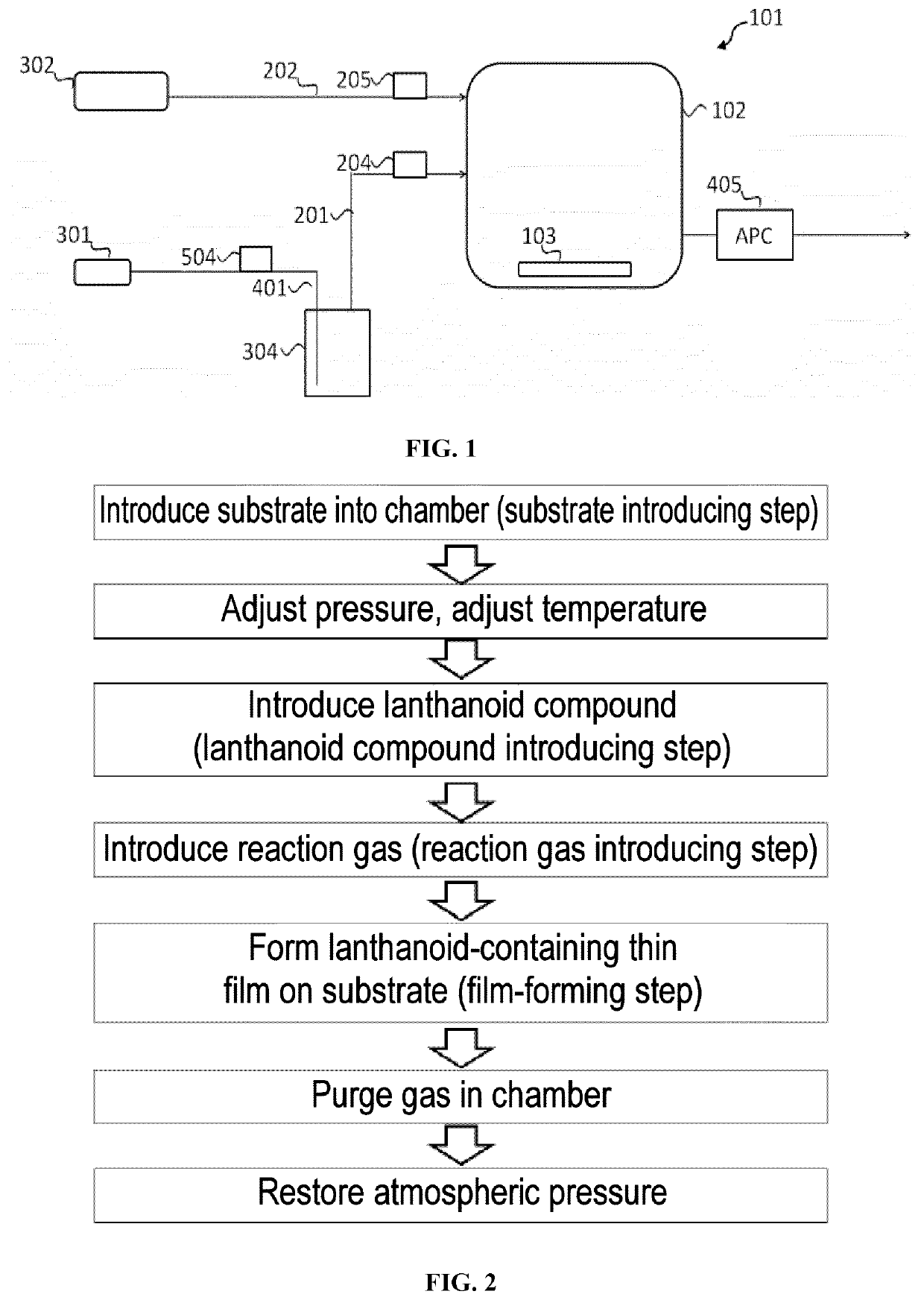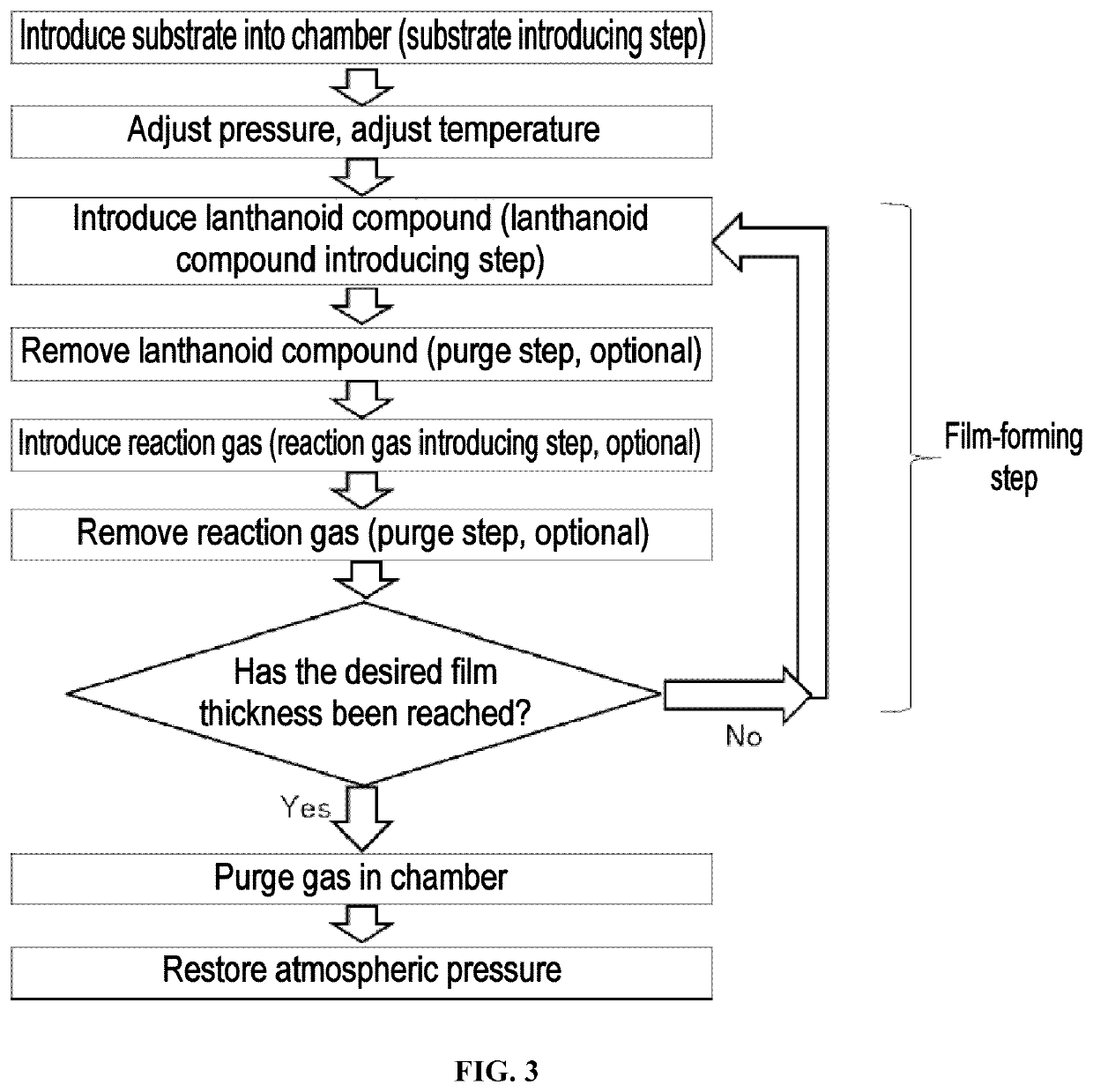Lanthanoid compound, lanthanoid-containing thin film and formation of lanthanoid-containing thin film using the lanthanoid compound
a technology which is applied in the field of lanthanoid compound and lanthanoid-containing thin film formation, can solve the problems of difficult handling, difficult to ensure the quantity of vapor required to form lanthanoid-containing thin film, and low thermal stability of trivalent lanthanoid compound having cyclopentadienyl, etc., to achieve sufficient vapor pressure and reactivity, the effect of high
- Summary
- Abstract
- Description
- Claims
- Application Information
AI Technical Summary
Benefits of technology
Problems solved by technology
Method used
Image
Examples
example 1
of Eu(iPr3Cp)2
[0129]A 1-L volume flask was charged with 400 mL of dehydrated diethyl ether and 35.7 g (0.18 mol) of K[N(SiMe3)2]. A solution of 38.1 g (0.20 mol, 1.1 equivalents) of iPr3CpH dissolved in 100 mL of dehydrated diethyl ether was dropped into the flask at room temperature (a temperature of 20° C.).
[0130]After the resulting reaction mixture was stirred for 12 hours using a magnetic stirrer, the supernatant liquid was removed to obtain a precipitated white solid.
[0131]The white solid was washed with 100 mL of dehydrated diethyl ether and 100 mL of dehydrated n-pentane, then solidified under reduced pressure to obtain K(iPr3Cp).
[0132]After this was combined with 34.9 g (0.09 mol) of anhydrous EuI2 and 500 mL of dehydrated THF and stirred for 48 hours at 20° C., the solvent (THF) was distilled off under reduced pressure to obtain an orange solid.
[0133]Next, the orange solid was combined with 500 mL of dehydrated n-pentane, and the orange filtrate was separated by filtration...
example 2
of Yb(iPr3Cp)2
[0143]A 250-mL volume flask was charged with 20 mL of dehydrated diethyl ether and 5.18 g (0.026 mol) of K[N(SiMe3)2]. A solution of 5.00 g (0.26 mol, 1.0 equivalent) of iPr3CpH dissolved in 10 mL of dehydrated diethyl ether was dropped into the flask at room temperature (a temperature of 20° C.). After the resulting reaction mixture was stirred for 12 hours using a magnetic stirrer, the supernatant liquid was removed to obtain a precipitated white solid.
[0144]The white solid was solidified under reduced pressure to obtain K(iPr3Cp). After this was combined with 5.09 g (0.012 mol) of anhydrous YbI2 and 50 mL of dehydrated THF and stirred for 48 hours at 20° C., the solvent (THF) was distilled off under reduced pressure to obtain a dark green solid.
[0145]Next, the dark green solid was combined with 100 mL of dehydrated n-pentane, and the green filtrate was separated by filtration.
[0146]The resulting filtrate was first solidified under reduced pressure at 20° C., then d...
example 3
of Yb2O3 Film by CVD Using Yb(iPr3Cp)2
[0157]A lanthanoid-containing thin film was formed on a substrate by hot CVD under the following conditions using Yb(iPr3Cp)2 as the lanthanoid compound and dry air as the reaction gas. A gas mixture of nitrogen and oxygen containing 20% to 22% oxygen and having a dew point of −69° C. was used as the dry air.
Film Formation Conditions
[0158]Apparatus used: An apparatus 101 having the configuration shown schematically in FIG. 1 was used. The substrate 103 was arranged in the chamber 102. The lanthanoid compound vessel 304 filled with Yb(iPr3Cp)2 was connected to the carrier gas intake pipe 401 and the lanthanoid compound feed pipe 201, which was connected to the chamber 102. Nitrogen gas as the carrier gas 301 was introduced through the carrier gas intake pipe 401 into the lanthanoid compound vessel 304 to bubble the nitrogen gas in the Yb(iPr3Cp)2. A mass flow meter was arranged above the lanthanoid compound feed pipe 201 as the lanthanoid compou...
PUM
| Property | Measurement | Unit |
|---|---|---|
| temperature | aaaaa | aaaaa |
| atmospheric pressure | aaaaa | aaaaa |
| temperature | aaaaa | aaaaa |
Abstract
Description
Claims
Application Information
 Login to View More
Login to View More - R&D
- Intellectual Property
- Life Sciences
- Materials
- Tech Scout
- Unparalleled Data Quality
- Higher Quality Content
- 60% Fewer Hallucinations
Browse by: Latest US Patents, China's latest patents, Technical Efficacy Thesaurus, Application Domain, Technology Topic, Popular Technical Reports.
© 2025 PatSnap. All rights reserved.Legal|Privacy policy|Modern Slavery Act Transparency Statement|Sitemap|About US| Contact US: help@patsnap.com



